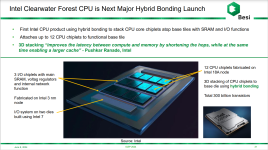I agree with what you said. That is why I said "technology leadership first, $$s will follow". And leadership includes performance and cost. We will have to wait and see how 18A progresses in the next few quarters.Kevin01 Said: "It is kind of laughable that Intel competitors won't use IFS. If IFS offers the best tech, and your competitors are using it to outrun you, you will be FORCED to use it, too."
If Intel is best, Of course people will use them. The question is whether Intel has the best tech and foundry services (delivery/price/PDK).
Perhaps we should wait to see how Intel is delivering actual products and processes before assuming Intel has leadership.
IBM announced leading 2nm GAA product in 2021 so perhaps IBM and Rapidus are the true leaders?
Lets see what happens.
Now, back to "competitors", I would argue there are many kinds of competitors, AMD is probably Intel product team's No.1 competitor, head-to-head on many product lines. But other than AMD, I can see the rest happily becoming IFS customers (if IFS is indeed the best), especially the ARM based chip makers.


